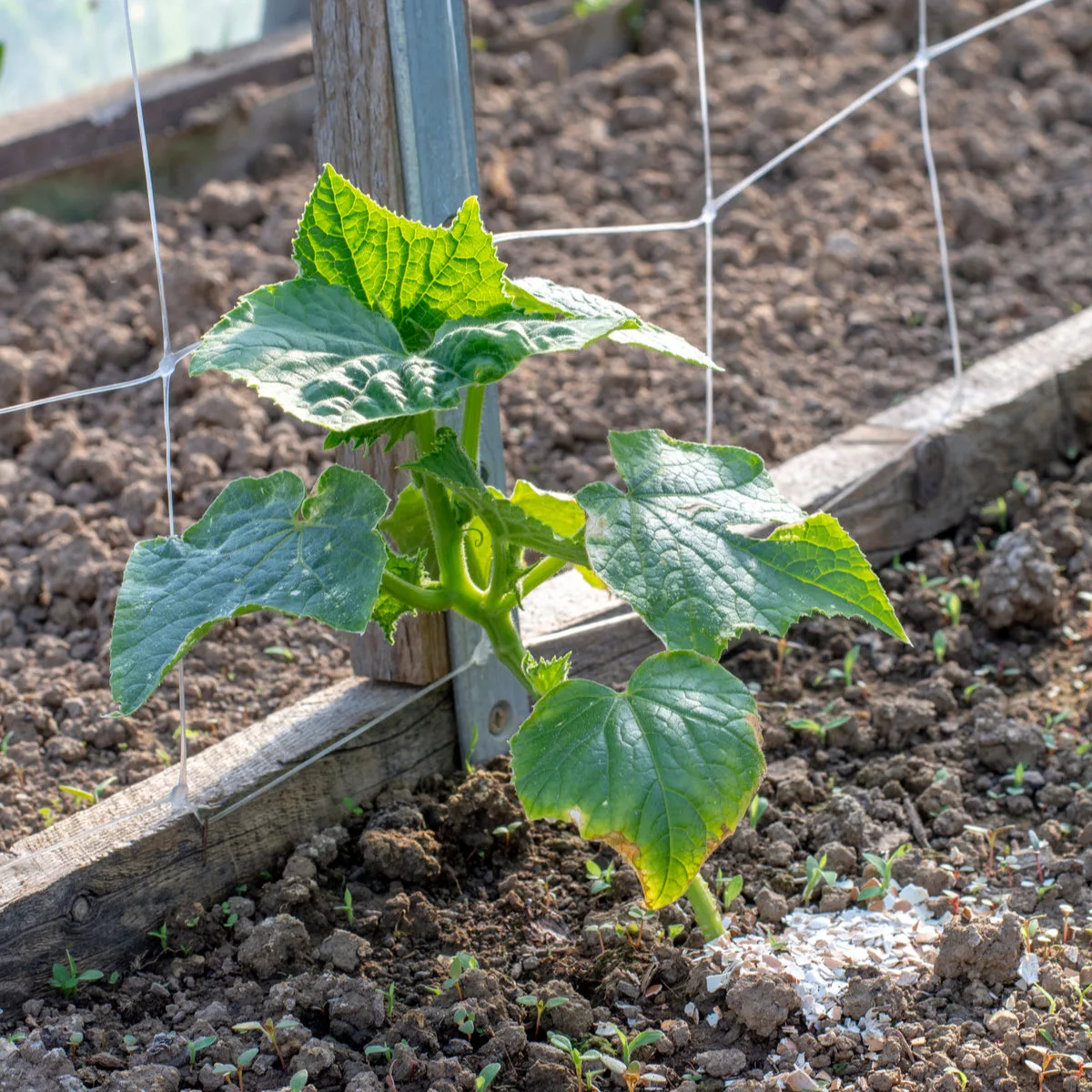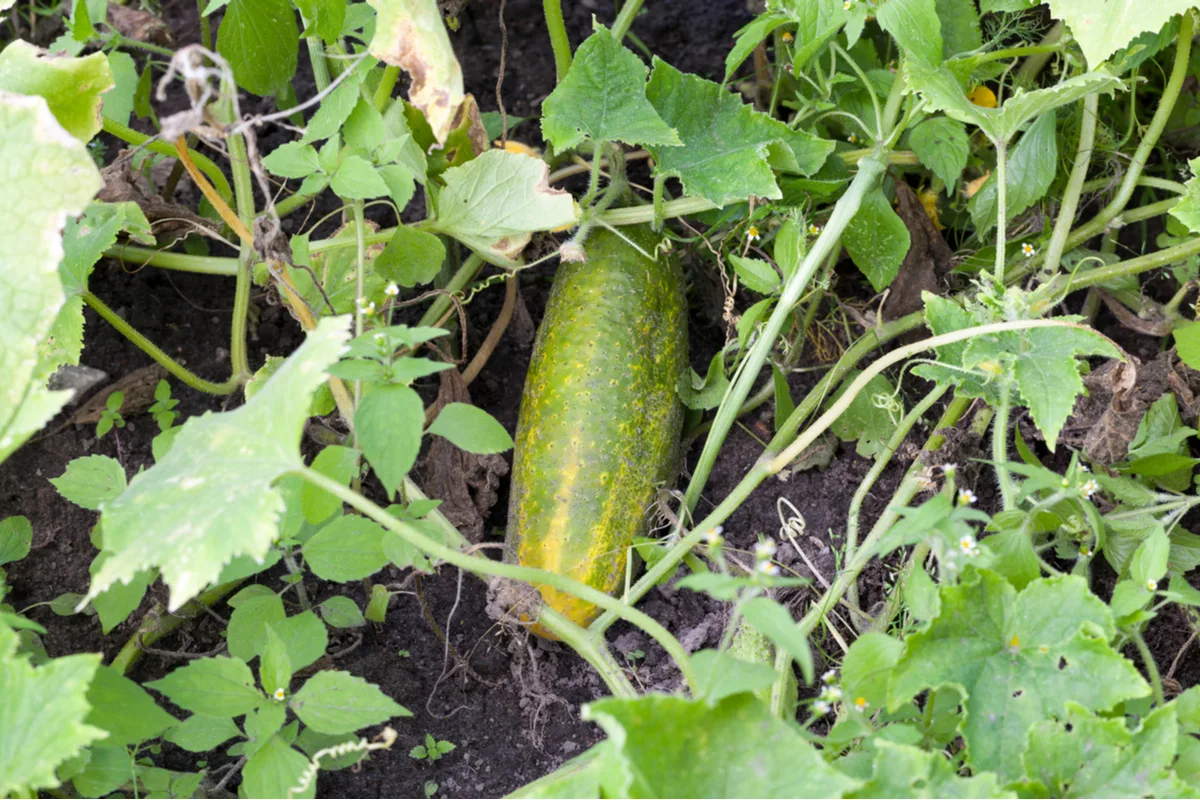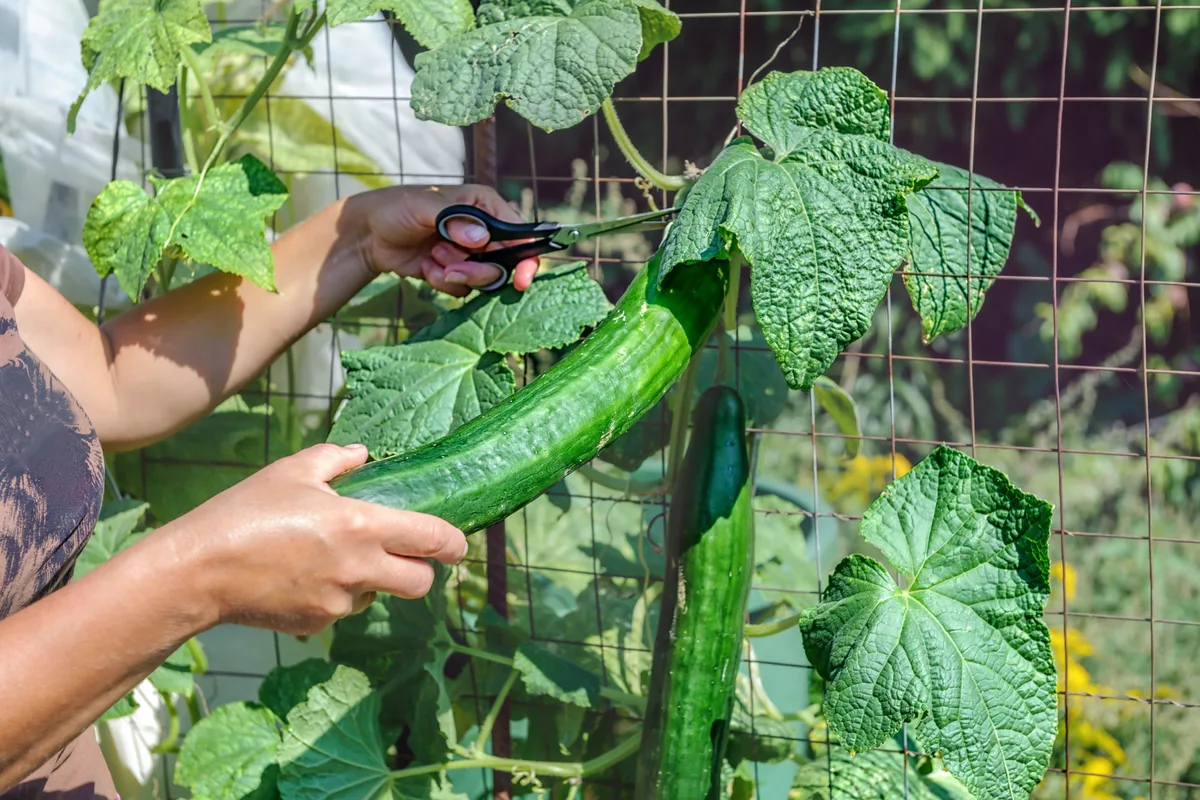
Cucumbers, like tomatoes, are on every gardeners planting list.
Perhaps it is because they taste great together in salads, or maybe because you envision a jar of homemade pickles in your future.
Unfortunately, there are some things that could stand in the way – between you and your best cucumber harvest ever.
With a little gardening know-how and know-why, you can overcome the following cucumber growing challenges this season:
- tough cucumber skins
- bitter cucumbers
- yellow cucumbers
- damage by insects
- vines not growing
- fruit not forming
- pollination problems
- and transplant shock
Though the challenges may be many, there are several tips and tricks to obtain consistent and abundant yields.
Become aware of them before sowing your first seeds and a beautiful, green cucumber harvest is yours for the taking.

1. Choose A Variety That’s Right For You

This isn’t so much of a planting tip as it is plain old garden sense.
In order to enjoy your cucumbers, you are going to have to choose the cucumbers you wish to eat.
Is it slicing cucumbers you want, such as English or European cucumbers?
Are you searching for something more exotic, such as lemon cucumbers, Persian or Japanese (Kyuri) cucumbers?

Socrates, Kirby, Korean, Watermelon Gherkins, Amiga – if you aren’t sure what cucumbers you need in your garden, grab some seed catalogs and plan some quiet time with the plant guides.
Your choice of cucumber variety might also be informed by how you wish to preserve your abundant harvest. Keep this in mind as you pick the right variety for your garden.
2. Knowing and Sowing Cucumber Seeds

One other important growing condition to keep in mind, is that cucumbers require a warm season, with sufficient sunlight. Not too much sun, nor too little.
Cukes are also susceptible to frost and light freezing. In addition, they will not tolerate foggy, damp summers.
So, now you know what growing conditions cucumbers prefer: not too hot, not too cold, not too wet and not too sunny.
Does it sound like the weather that appears in the height of your summer garden?
If not, it may lead you to ask yourself, how do they grow fabulously green and crisp cucumbers to sell in the supermarkets? Well, with that question you are probably getting into trade secrets, such as top fertilizing methods and F1 hybrids.
More important than that, however, is that cucumbers grow best in a greenhouse where you can more easily modify the elements. Light intensity, wind, irrigation and so on.

But that doesn’t mean cucumbers can’t grow well outside, either.
If you have a greenhouse, sow cucumber seeds both indoors and out. Carry out your own trials and see what grows best for you.
To grow a cucumber from seed, you have two choices:

- direct sowing – it’s as easy as pushing the seed in the soil. No worries about caring for the seedlings or transplanting them later on.
- starting seeds indoors – this option is a little more time consuming, though it is absolutely perfect for those gardeners with shorter growing seasons.
Cucumber seeds should be sown outdoors a week, or two, after your last frost. The soil must be warm enough for germination to occur.

To start them indoors, plan to sow your seeds 4-6 weeks before your average last frost date.
Cucumbers germinate fairly quickly in about a week. They are especially fast when heated up by the sun, or an indoor heat mat. This feature makes them fun to grow, you can almost watch them emerge from the soil. So, get the kids involved in growing cucumbers too, it’s fun and educational.
3. Moving Transplants

You can automatically skip this step if you’ve decided to direct sow your cucumber seeds.
However, if your seeds were sown in pots, then this transplanting tip is for you.
The biggest mistake you can possibly make when transplanting cucumbers is to move them too quickly into the garden.
Cukes can’t take the cold, or potential frost.
Before moving your seedlings into the garden, be sure to harden off your plants first.
This involves exposing your plants to the elements for an increasing amount of time each day. Start with an hour per day, then move your plants back inside. Gradually increase the time your plants are outside until they are ready to be moved outside permanently.
As you remove the seedlings from their pots, be sure to handle them gently, as cucumbers prefer not to have their roots disturbed.

With a small trowel, dig a hole, slightly larger than the rot ball (or peat pot if you’ve chosen the easiest growing method). Place the roots into the ground, being sure to give your cucumbers plenty of space – about 12″ apart in a row, with 24″ between rows. Don’t forget for a moment that cucumbers like to sprawl.

After tamping down the soil, make sure to water the seedlings deeply. From then on, once or twice a week watering should be sufficient.
Too much rain, however, is quite another challenge with mildew and fungus.
Related reading to make the most efficient use of your garden space: 12 DIY Cucumber Trellis and Support Ideas
4. Companion Planting With Cucumbers

When growing your cucumbers out in the garden, you are going to need some allies. Friends that will help protect against bugs and bacteria.
These “friends” can come in the form of plants, should you be willing to implement a companion planting strategy for your best ever cucumber harvest.
You can take some time to read the long version of cucumber companion planting, or take my word for it and observe the quick list of cucumber beneficial companions below:

- beans
- beets
- celery
- corn
- dill
- lettuce
- marigolds
- nasturtiums
- peas
- radishes
- sunflowers

It’s also good to know a few herbs and veggies not to plant with your cucumbers:
- aromatics: basil, sage and peppermint
- melons
- potatoes
When all is said and done, you are either into companion planting or not. For some gardeners it works a treat, for others it feels like too much time and effort. The good thing is, you can grow cucumbers either way.
How many cucumbers you can grow, is also up to your soil, fertilizer and irrigation methods.
5. Soil Quality + Fertilization + Mulching

What kind of soil do cucumbers prefer to grow in? A loose, sandy loam is their top pick.
But you have to remember that their roots grow deep. Their single tap root can extend three to four feet below the soil, with numerous branching roots around the two foot zone. So, underground, they take up plenty of space.
Right now, your brain might be hard at work, trying to figure out if cucumbers can grow in your rocky or clay soil.
The short answer is yes, you certainly can. Cucumbers may even surprise you with heavier yields in clay soils, though they’ll produce an earlier crop in sandy soils (where the ground heats up faster).
PH-wise, cucumbers are best planted in soil with a pH between 5.5 to 7.0. If you are unsure of your soil pH, get a soil test done. You can find out a lot about your garden this way.
The right way to fertilize your cucumbers:

Now, that we’ve established that cucumbers can thrive in all sorts of soils, the three things they can’t live without are water, compost and well-rotted manure.
But when should they be fertilized?
It’s not enough to toss some manure at them and leave them alone.
There are three times in the growing season to give cucumbers the nutrients they need.
- at the time of planting
- when you begin mulching (that’s a hidden tip for your best ever cucumber harvest!)
- at set intervals as the plants develop
Every gardener has heard about the wonders of compost. Follow by example here and take the advice of gardeners all over the world, add a rich handful of compost to each planting hole. Yes, you can even add worm castings.
If you have both worm castings and compost, toss in a little of both. Your cucumbers will thank you later.
Mulching is the best kept secret.

If you’ve direct sown your seeds, the best time to mulch them is when they’ve developed a few leaves. The mulch not only acts as an excellent weed barrier, it also helps to regulate the soil temperature.
Add another handful of compost and worm castings before you lay down that straw, hay, or grass clippings though, and your cucumbers will love you even more.
Transplants can be mulched as you put them in the soil. Don’t forget the compost.
Fertilizing cucumbers throughout the growing season.
Cucumbers are heavy feeders like corn, eggplant, peppers, squash and tomatoes. Those are many of the plants you love, right?
Well, if you want to see many of them on your dinner table, you’ve got to take good care of them first.
The key to fertilizing your cucumbers is to keep the applications light and regular.
Use too much fertilizer and you’ll get a lot of leaves and few blossoms – which means little to no fruit. The trick is in finding the right amount of fertilizer and the best solution. This may take some trial and error on your part.
Check out our article on homemade fertilizers for more information : 10 Liquid Fertilizer Teas Made From Weeds and Plants

Use a light dose of a liquid fertilizer every two weeks for your best cucumber harvest. Keep in mind, that once the plants begin producing blossoms, you can back off on the fertilizer completely. From then on, it is simply regular watering that is necessary.
6. No Flowers = Pollination Problems

As previously mentioned, you need to find the correct amount and right type of fertilizer that is best for your cucumbers. This will ensure you have enough blossoms to become fruit.
What you need to know about blossoms, is that male flowers appear first, followed by female flowers. So, not all flowers will become a cucumber.


If you find that your cucumber plants have a lot of blossoms, but they aren’t being pollinated, it’s likely that you have a lack of pollinators in your garden.
You can, of course, pollinate cucumbers by hand if there are not enough pollinators around. The process is very similar to hand pollinating squash.
Outside of this mechanical work, be sure to plan your garden in such a way as to attract as many pollinators as possible. It’s mainly honeybees and bumblebees who are pollinating cucumbers, so be sure to cater to them.

You can attract more pollinators to your garden by planting flowers and herbs. Another thing you can do, is provide a source of water, even in the form of a shallow bird bath.
7. Harvesting Cucumbers The Right Way

Now you know how to grow a great bushel of green cucumbers. The next step is to harvest them while they are perfectly ripe.
How do you know when cucumbers are ripe for the picking?
For starters, days to harvest should be listed on the back of your seed package. If you’ve already tossed that info out, don’t worry, it’s just an estimate. Most varieties of cucumbers are ready for eating 50-70 days after germination.
Depending on how many cucumber plants you have growing in your garden, you may be able to harvest them every other day. Or even every day, if you are an over-achiever with a larger garden.
Cukes must be picked when they are totally green, before they show any signs of yellowing (an indicator that they are past their sweetest prime).

It’s also useful to remember what kind of cucumbers you planted. In general they should reach the appropriate size and length before picking. Pickling cucumbers at 2-6″. Slicing cucumbers at 6″.
Be sure to cut them off the plant with kitchen shears or pruners. Never pull them as the vine is sensitive and other fruits may still be growing on it.

The best time of day to harvest cucumbers? Morning is best. You’ll want to harvest your fresh cucumbers when the vines are cool and the fruits full of water.
As you harvest the cucumbers for lunch, be sure to remove any rotten or stunted fruits, so they do not put additional strain on the plant.
Outside of that, harvest your cukes as often as needed, gathering them gently in a basket, just as you would a soft, ripe fruit.
8. Storing Cucumbers For Extended Enjoyment

Fresh cucumbers are a fantastic garden treat, right along with all the tomatoes you can fill in a bucket.
Unfortunately they don’t last very long off the vine.
We’ve compiled a list of 10 non-pickle ways to preserve cucumbers + 5 killer pickles for you to salivate over, to get started. However, if you don’t have quite the garden to go into full preservation mode, you can still get good use out of your fridge to keep them fresh for longer.
To keep your cucumbers as crisp as possible, without turning into a yucky mush, store them in the fridge.
Unwaxed cucumbers, the kind you’ll be harvesting from your garden, are best eaten within 3 days. Store-bought cucumbers are often waxed and can be stored for up to a week, uncut, in your crisper drawer.
You’ll also want to make sure they are completely dry and free of dirt. If you choose to wash them, be sure to dry them off before wrapping them in a clean dishtowel. You can also wrap them in a clean paper towel before setting them in the fridge. This helps to prevent sogginess and preserve freshness.
I heard someone asking about storing cucumbers in plastic bags…
Stored loosely in a plastic bag, cucumbers last about 4-5 days.
In a zip-lock bag, you don’t want to wait more than a week to consume them.
However, when cukes are tightly wrapped in plastic, they can last up to 10 days.
To extend your cucumber harvest, choose the method that works best for you.
It comes down to this: even though cucumbers have a myriad of pests and diseases, there are plenty of wonderful reasons to grow them, even for the love of flavor alone.

So long as you take measures to keep your soil healthy and give your growing cucumbers adequate water and nutrition, providing extra care if and when necessary, you are guaranteed to have healthy, productive vines.
We wish you a happy cucumber harvest and happy pickling season too, should your crop be beyond your wildest dreams.

Get the famous Rural Sprout newsletter delivered to your inbox.
Including Sunday ramblings from our editor, Tracey, as well as “What’s Up Wednesday” our roundup of what’s in season and new article updates and alerts.

